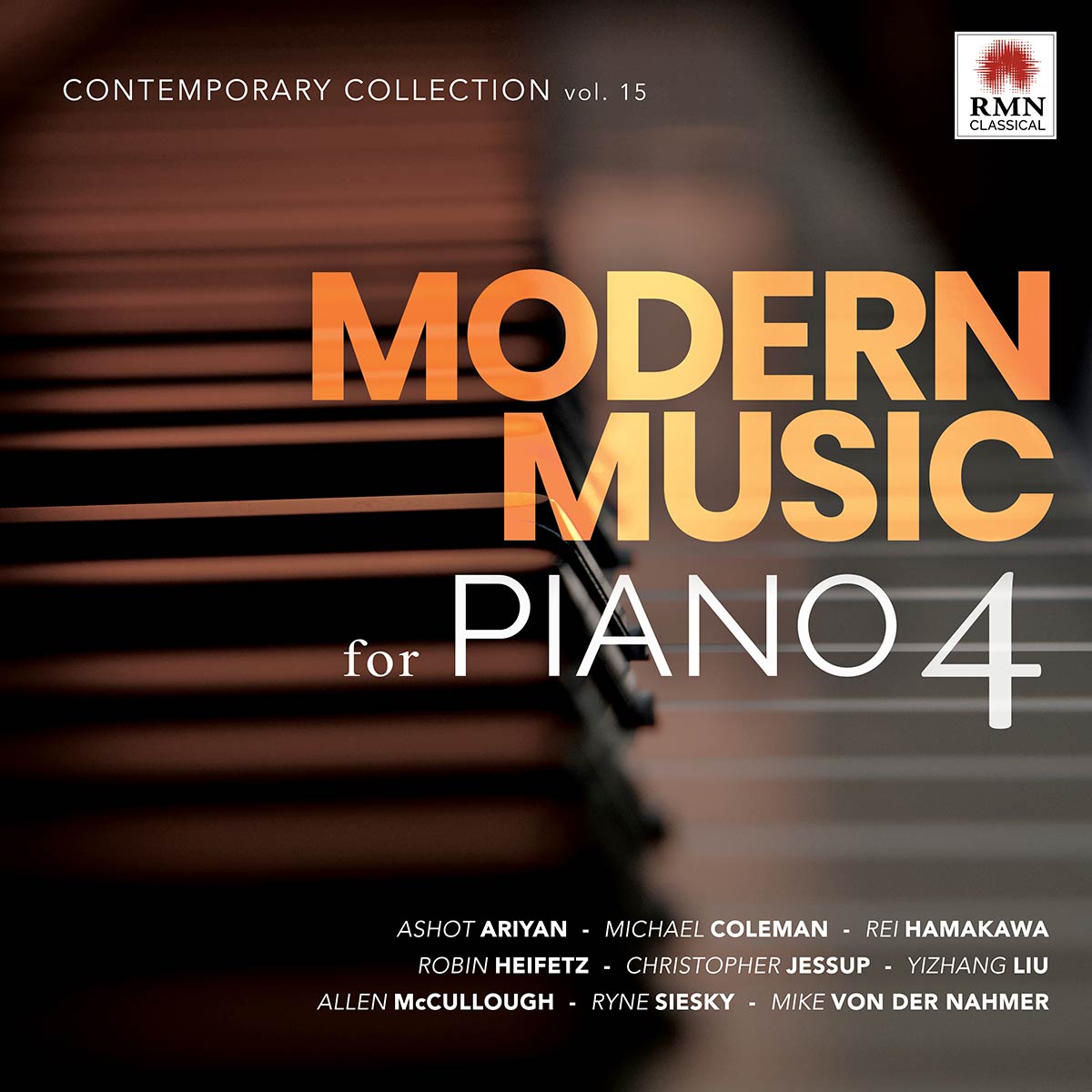MUSIC > Modern Music for Piano 4

Title: Modern Music for Piano 4
Release Date: 27 May 2022
Label: RMN Classical
Produced by R. Romano
Cover design by RMN Classical
Performed by
(in order of playlist)
01 - 03. David Henry
04. Hirofumi Uematsu
05. Christopher Jessup
06. Valerie Wellington
07. Graciella Kowalczyk
08 - 11. Xander Rovang
12 - 15. Inesa Gegprifti
16. Jacob Mason
17. Edward Cohen
Modern Music for Piano 4 by Various Artists
| N. | Play | Title | Composer | Time |
| 01 | Prelude 2 | Allen McCullough | 01:05 | |
| 02 | Prelude 3 | Allen McCullough | 01:27 | |
| 03 | Prelude 4 | Allen McCullough | 00:57 | |
| 04 | Fantasy on a Theme of Akatombo (Red Dragonfly) | Rei Hamakawa | 04:38 | |
| 05 | Le Revenant (Live) | Christopher Jessup | 07:24 | |
| 06 | Tempestuous Flow (Live) | Yizhang Liu | 04:37 | |
| 07 | Fugue and Postlude in A | Ashot Ariyan | 05:33 | |
| 08 | Psychogramm Mov. I | Mike von der Nahmer | 02:12 | |
| 09 | Psychogramm Mov. II | Mike von der Nahmer | 03:41 | |
| 10 | Psychogramm Mov. III | Mike von der Nahmer | 04:23 | |
| 11 | Psychogramm Mov. IV | Mike von der Nahmer | 01:59 | |
| 12 | Four Bagatelles: no. 1 (Live) | Michael Coleman | 01:11 | |
| 13 | Four Bagatelles: no. 2 (Live) | Michael Coleman | 00:41 | |
| 14 | Four Bagatelles: no. 3 (Live) | Michael Coleman | 01:47 | |
| 15 | Four Bagatelles: no. 4 (Live) | Michael Coleman | 01:20 | |
| 16 | Glass, Evaporate[d] | Ryne Siesky | 04:28 | |
| 17 | Whiteknuckle | Robin Heifetz | 09:57 |
Composed in 2011 for pianist David Henry, Allen McCullough’s 12 Preludes for Piano resulted from a grant extension from the Office of the Provost at Mercer University where Dr. McCullough was music faculty from 2009-2012.
The tempestuous 2nd prelude quickly reaches a climax, as a “swelling” figure unfolds from the lowest E-flat on the piano – which is heard as a “tonic” of sorts via repeated iteration – to its highest register. Following a middle section that is perhaps reminiscent of the knotty middle portion of Chopin’s “Tristesse” Étude Op.10 No.3, the opening section is recapitulated, but with the addition of a B-flat pedal tone interjected amid the already-busy “swelling” figure – certainly a pianistic challenge.
Contrasting the tumult of the 2nd prelude, prelude no.3 is docile in character, with a focus on melody. Marked “tenderly” in the score, the melody culminates with a poignant and introspective gesture, just before coming to an enigmatic close.
Along with a return to a faster tempo akin to the 2nd prelude, the playful character of prelude no.4 contrasts the gentle nature of the 3rd prelude. Built primarily on quartal and quintal harmonies, the prelude navigates fluid polyrhythms and asymmetric meters as a nearly tonal climax is achieved midway through the piece. To end, a quiet staccato gesture pinpoints E-flat as “tonic” yet again, providing a sense of closure to this subset trio of preludes among the total group of twelve.
Akatombo (Red Dragonfly) is among the best-known Japanese nursery rhymes written by Rufu Miki. The music for the text was composed by composer Kósçak Yamada in 1927. The composition was ranked first in a survey conducted by the NPO Japan Children's Song Society in 2003. The Japanese Ministry of Education, Culture, Sports, Science and Technology's Agency for Cultural Affairs included it on their 2007 list of 100 Japanese songs that are widely beloved in Japan.
The melody of Akatombo is written in a pentatonic scale called yonanuki (the name comes from yo [4], na [7], and nuki [remove]), which is commonly used in Japan, based on the Western major scale with the fourth and the seventh tones removed. By daring to add the fourth tone back into the scale, which is familiar to Japanese people from songs that use a Western structure, Yamada was able to create a melody that seems Western but is easily accepted by Japanese people and remains in their hearts.
The composition here, based on the Akatombo theme, is written for the left hand alone, and in it, the image of a red dragonfly appears, sometimes high, sometimes low, in movement, sometimes quiet, sometimes flitting about. Fragments of this melody appear throughout the piece. The composer idea was also to evoke a sense of late summer and autumn in Japan when the red dragonflies dance during dusk.
Glass, Evaporate[d] is a work written for three quarter-tuned pianos and originates from the curiosity of the composer to explore this direction after accidentally displacing a few tracks during a session of a different work titled lips evaporate for double bass and piano. While mixing the recordings, the composer's curiosity spiked after accidentally displacing the tracks in the session. Glass, evaporate[d] is the self-plundered amalgamation of this experiment.

